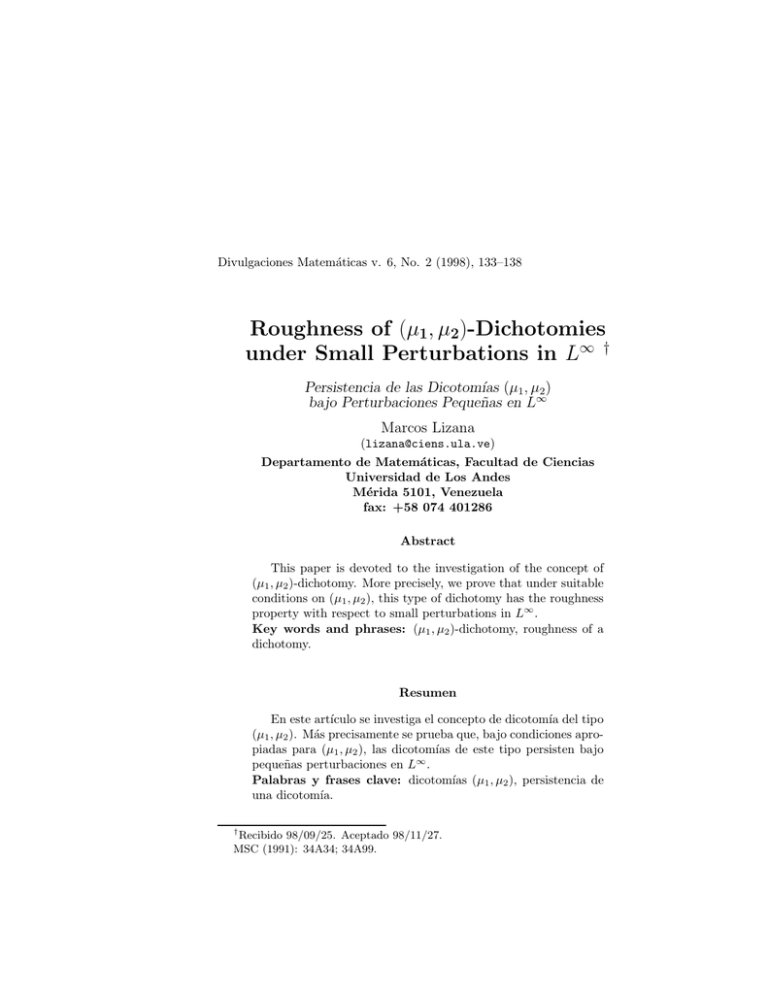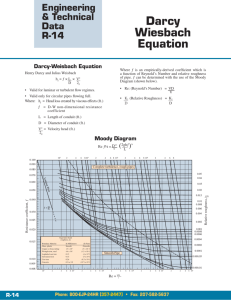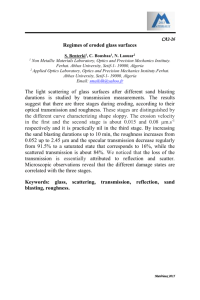µ )-Dichotomies L , µ
advertisement

Divulgaciones Matemáticas v. 6, No. 2 (1998), 133–138
Roughness of (µ1, µ2)-Dichotomies
under Small Perturbations in L∞ †
Persistencia de las Dicotomı́as (µ1 , µ2 )
bajo Perturbaciones Pequeñas en L∞
Marcos Lizana
(lizana@ciens.ula.ve)
Departamento de Matemáticas, Facultad de Ciencias
Universidad de Los Andes
Mérida 5101, Venezuela
fax: +58 074 401286
Abstract
This paper is devoted to the investigation of the concept of
(µ1 , µ2 )-dichotomy. More precisely, we prove that under suitable
conditions on (µ1 , µ2 ), this type of dichotomy has the roughness
property with respect to small perturbations in L∞ .
Key words and phrases: (µ1 , µ2 )-dichotomy, roughness of a
dichotomy.
Resumen
En este artı́culo se investiga el concepto de dicotomı́a del tipo
(µ1 , µ2 ). Más precisamente se prueba que, bajo condiciones apropiadas para (µ1 , µ2 ), las dicotomı́as de este tipo persisten bajo
pequeñas perturbaciones en L∞ .
Palabras y frases clave: dicotomı́as (µ1 , µ2 ), persistencia de
una dicotomı́a.
†
Recibido 98/09/25. Aceptado 98/11/27.
MSC (1991): 34A34; 34A99.
134
1
Marcos Lizana
Introduction
Suppose A ∈ C(J, S n×n ), where J = (a, b) with −∞ ≤ a < b ≤ ∞ and S is
the set of real or complex numbers. Let Φ be a fundamental matrix solution
for the linear homogeneous differential system
x0 = A(t)x,
t ∈ J.
(1.1)
If µ1 and µ2 are continuous real valued functions on J, the system (1.1) will
be said to have a (µ1 , µ2 )-dichotomy if there exist supplementary projections
P1 and P2 on Rn and a constant K > 0 such that
Z t
kΦ(t)Pi Φ−1 (s)k ≤ K exp(
µi (τ ) dτ ) if (t − s)(−1)i−1 ≥ 0, i = 1, 2.
s
(1.2)
In the case that µ1 and µ2 are constants, the system (1.1) is said to have
an exponential dichotomy if µ1 < 0 < µ2 , and an ordinary dichotomy if
µ1 = µ2 = 0.
The condition (1.2) is readily seen to be equivalent to
Z t
kΦ(t)Pi ξk ≤ K exp(
µi (τ ) dτ )kΦ(s)Pi ξk, if (t − s)(−1)i−1 ≥ 0, i = 1, 2,
s
(1.3)
kΦ(t)Pi Φ−1 (t)k ≤ K,
i = 1, 2.
(1.4)
Condition (1.4) says that the angle between Φ(t)Pi Rn (i = 1, 2) remains
bounded away from zero. The two cases of most interest are where J is the
positive half-line R+ and the whole line R. Hereafter we assume that J = R.
This definition was introduced by J. S. Muldowney in [4]. There, three
sets of necessary and sufficient conditions for a (µ1 , µ2 )-dichotomy were given
in terms of Liapunov functions. Each result gives practical criteria for a
dichotomy, including the extension to unbounded matrices of criteria which
depend on a concept of diagonal dominance for A(t). An asymptotic analysis
is also given for subspaces of the solution set by means of the associated
compound equations.
This paper is devoted to further investigations of this concept of dichotomy. More precisely we prove that, under suitable conditions on (µ1 , µ2 ),
this type of dichotomy has the roughness property with respect to small perturbations in L∞ .
Roughness of (µ1 , µ2 )-Dichotomies in L∞
2
135
Roughness of a (µ1 , µ2 )-dichotomy
In the proof of the roughness property of a (µ1 , µ2 )-dichotomy, it will be very
important that the following “functions” :
∗
u (t) =
v ∗ (t) =
Z
t
−∞
Z ∞
Z t
exp( [µ1 (τ ) − µ2 (τ )] dτ ) ds,
(2.5)
exp(
(2.6)
t
s
Z t
s
[µ2 (τ ) − µ1 (τ )] dτ ) ds,
be well defined and bounded on R. We sketch a few facts that will help us to
clarify this point.
Throughout the following, B = {f : R → Cn , f continuous and bounded}
and for any f in B, |f | = sup{|f (t)| : t ∈ R}. The subset AP of B denotes
the set of almost-periodic functions. The subset Pω of AP denotes the set
of periodic functions of period ω. An n × n matrix function on R is said to
belong to one of these spaces if each column belongs to the space.
Let us define the operator Lx := x0 − A(t)x with A ∈ B. The operator L
is said to be regular if the equation Lx = f has a unique solution in B, for
any f ∈ B. If the equation Lx = f has at least one solution in B, for each
f ∈ B, L is said to be weakly regular. In general, weak regularity does not
imply regularity. Consider for instance the following equation
x0 (t) = a(t)x(t) + f (t),
−1,
−t,
a(t) =
1,
(2.7)
t≥1
−1 < t < 1
t ≤ −1.
Nevertheless, if A ∈ AP, then regularity and weak regularity are equivalent.
See [2, Thm. 2.3, p. 26].
In the scalar case (2.7), being a ∈ AP, J. L. Massera proved in [3] that L
is regular if and only if
1
T →∞ 2T
M (a) = lim
Z
T
−T
a(t) dt 6= 0.
From this result it follows that the set of all regular operators L is dense in
the space of almost-periodic operators. From the former discussion the next
result is immediate:
136
Marcos Lizana
Lemma 1. Suppose that a ∈ AP and M (a) < 0, where a(t) = µ1 (t) − µ2 (t).
Then (2.5) and (2.6) are the unique solutions in B of the equations
u0 (t) =
0
v (t) =
(µ1 (t) − µ2 (t))u(t) + 1,
(µ2 (t) − µ1 (t))v(t) − 1,
respectively.
If a(t) = µ1 (t) − µ2 (t) is just a bounded function and
1
lim sup
t
−
s
(t−s)→∞
Z
t
a(τ ) dτ < 0,
s
the same assertion holds.
When A ∈ Pω , L is regular if and only if the only solution of (1.1) which
belongs to B is the solution x = 0.
The following result shows when a (µ1 , µ2 )-dichotomy cannot be destroyed
by small perturbations in L∞ .
Theorem 2. Let us assume that system (1.1) has a (µ1 , µ2 )-dichotomy and
that (2.5) and (2.6) are bounded functions on R. If B(t) ∈ B and δ =
sup{|B(t)| : t ∈ R}, then the perturbed equation
x0 = [A(t) + B(t)]x,
t ∈ R,
(2.8)
has a (µ01 , µ02 )-dichotomy for δ small enough, where µ01 = µ1 + 6K 3 δ and
µ02 = µ2 − 6K 3 δ.
Proof. Since (1.1) admits a (µ1 , µ2 )-dichotomy, (1.4) holds. Then, by Lemma 2
in [1, p. 40], there
differentiable invertible matrix T (t)
√ exists a continuously
√
with kT (t)k ≤ 2, kT −1 (t)k ≤ 2K, such that the change of variables
x = T (t)z transforms (2.8) into the system
z 0 = [C(t) + D(t)]z,
(2.9)
whose coefficient matrix C(t) = T −1 (t)A(t)T (t) − T −1 (t)T 0 (t) is Hermitian,
commutes with P1 and P2 , and satisfies kC(t)k ≤ kA(t)k, ∀t ∈ R. Moreover,
kD(t)k = kT −1 (t)B(t)T (t)k ≤ 2Kδ, ∀t ∈ R.
Our next object is to transform the system (2.9) into a kinematically
similar system whose coefficient matrix commutes with P1 and P2 .
Roughness of (µ1 , µ2 )-Dichotomies in L∞
137
Denoting by Φ(t) the fundamental matrix of (1.1) and observing that
Z(t) = T −1 (t)Φ(t) is a fundamental matrix of the system z 0 = C(t)z, we
obtain that
Z t
kZ(t)Pi Z −1 (s)k ≤ 2K 2 exp(
µi ), (t − s)(−1)i−1 ≥ 0, i = 1, 2. (2.10)
s
Let us define an operator F on the space B(R, Rn×n ) of the continuous and
bounded matrix functions as follows :
Z t
FH(t) :=
Z(t)P1 Z −1 (s)[I − H(s)]D(s)[I + D(s)]Z(s)P2 Z −1 (t) ds
−∞
Z ∞
−
Z(t)P2 Z −1 (s)[I − H(s)]D(s)[I + D(s)]Z(s)P1 Z −1 (t) ds.
t
Using (2.10) and the fact that u∗ and v ∗ are bounded on R, it can be proved
that F is a contraction and maps the ball kHk ≤ 1/2 into itself, if δ is
sufficiently small. Let H ∗ be the unique fixed point of F in kHk ≤ 1/2 .
Making the transformation z = [I + H ∗ (t)]v and arguing like in [1]
pp. 42–44, system (2.9) becomes:
v 0 = [C(t) + D∗ (t)]v,
(2.11)
where the coefficient matrices of (2.11) commute with P1 and P2 . Hence,
(2.11) decomposes into two independent subsystems. The rest of the proof
goes in a similar manner to [1] pp. 43–44.
Remark. In the case that µ1 < 0 < µ2 are constants, i.e., the system (1.1)
has an exponential dichotomy, the boundedness of u∗ and v ∗ is automatically
satisfied.
We point out that [5] proved roughness with respect to small L1 perturbations of A(t), which in general does not imply roughness with respect to
small L∞ perturbations.
References
[1] Coppel, W. A., Dichotomies in Stability Theory, Lect. Notes in Math. V.
629, Springer Verlag, 1978.
[2] Krasnosielski, M. A., Burd V. Sh., Koliesov Yu. S., Nonlinear Almostperiodic Oscillations, Nauka-Moscow, 1970 (in russian).
138
Marcos Lizana
[3] Massera, J. L., Un criterio de existencia de soluciones casi-periódicas de
ciertos sistemas de ecuaciones diferenciales casi-periódicos, Boletı́n Fac.
de Ing. y Agr. (Montevideo) V.6, N.11, (1958), 345–349.
[4] Muldowney, J. S., Dichotomies and asymptotic behavior for linear differential systems, Trans. AMS 283, N.2 (1984), 465–484.
[5] Naulin, R., Pinto M., Roughness of (h, k)-dichotomies, JDE 118(1995),
20–35.





